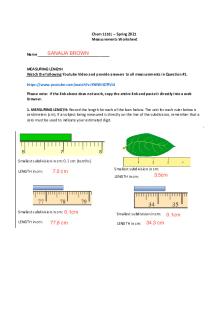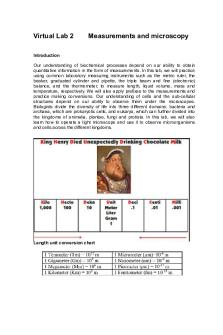PHY-111L-RS-Lab1 Measurements diameter and circumfrance PDF

| Title | PHY-111L-RS-Lab1 Measurements diameter and circumfrance |
|---|---|
| Author | Lanaya Williams |
| Course | University Physics I |
| Institution | Grand Canyon University |
| Pages | 3 |
| File Size | 267.1 KB |
| File Type | |
| Total Downloads | 100 |
| Total Views | 140 |
Summary
How to find the circumference and the relation to the diameter...
Description
Lab 1: Measurements 1. Testable Question: How is circumference of the circle related to the diameter of the circle? 2. Hypothesis: As the circumference of the circle increases than the diameter will increase because the round objects. 3. Variables: Control: Circular objects Independent: Diameter of the circle (D) cm Dependent: Circumference of the circle (C) cm 4. Table Design: Circular Objects i D (cm) C (cm) 1–8 D 1–8 C 1–8 5. Materials: • 8 round objects (different sizes) • String • Ruler • Marker 6. Procedure: • Gather 8 different round objects • Obtain proximally 1 meter of string, a ruler, and a marker • Created a simple excel table with 3 columns • Measure diameter of each round object with ruler then record in excel • Measure circumference of each round object with string by wrapping it around object • With marker dot to help indicate where string overlaps • Unwrap string and pull next to ruler • Identify the measurement, and record in excel • Create graph in excel, labeling axis and titling • Generate the equation an R2 for linear line • Translate excel equation with personal data © 2017. Grand Canyon University. All Rights Reserved.
Then manually add it to the graphic
• 7. Data:
measured d circular object (cm) measured c (cm) 1 5 17 2 3.2 10.5 3 4.8 16.1 4 3.4 11.9 5 3.7 12 6 7.5 24.2 7 22.6 28.5 8 26 94.3
8. Analysis:
Circumference vs. Diameter 100 y = 2.522x + 2.7909 R² = 0.6968
90
Circumference C (cm)
80 70 60 50 40 30 20
C = 2.52 (d) + 2.791
10 0 0
5
10
15
20
Diameter D (cm)
% error = 3.14 - 2.52/ 3.14 *100 = 19.74% 9. Conclusion: © 2017. Grand Canyon University. All Rights Reserved.
25
30
To answer the testable question, the circumference of a circle is linear to the diameter of the circle because C = 2.52 (d) + 2.791. 10. Evaluation: The hypothesis that was made was supported because as the circumference of the circles increased than the diameter increased as well. The level of accuracy during this experiment was 19.74% . A reason for possible systematic error could have resulted from when the string was cut, and the ends unwounded so when one of my lab group members measures the circumference than it won’t line accordingly while wrapping the circular object also when being held next to ruler. As for a random possible source of error could have resulted from tension on the string when it was being pulled around the circular object.
LaNaya Williams Wednesday, January 5, 2022
© 2017. Grand Canyon University. All Rights Reserved....
Similar Free PDFs

Circles-diameter-radius Twddf
- 2 Pages

A Measurements and Errors ppt
- 9 Pages

HEIGHT MEASUREMENTS
- 34 Pages

LINEAR MEASUREMENTS
- 16 Pages
Popular Institutions
- Tinajero National High School - Annex
- Politeknik Caltex Riau
- Yokohama City University
- SGT University
- University of Al-Qadisiyah
- Divine Word College of Vigan
- Techniek College Rotterdam
- Universidade de Santiago
- Universiti Teknologi MARA Cawangan Johor Kampus Pasir Gudang
- Poltekkes Kemenkes Yogyakarta
- Baguio City National High School
- Colegio san marcos
- preparatoria uno
- Centro de Bachillerato Tecnológico Industrial y de Servicios No. 107
- Dalian Maritime University
- Quang Trung Secondary School
- Colegio Tecnológico en Informática
- Corporación Regional de Educación Superior
- Grupo CEDVA
- Dar Al Uloom University
- Centro de Estudios Preuniversitarios de la Universidad Nacional de Ingeniería
- 上智大学
- Aakash International School, Nuna Majara
- San Felipe Neri Catholic School
- Kang Chiao International School - New Taipei City
- Misamis Occidental National High School
- Institución Educativa Escuela Normal Juan Ladrilleros
- Kolehiyo ng Pantukan
- Batanes State College
- Instituto Continental
- Sekolah Menengah Kejuruan Kesehatan Kaltara (Tarakan)
- Colegio de La Inmaculada Concepcion - Cebu











